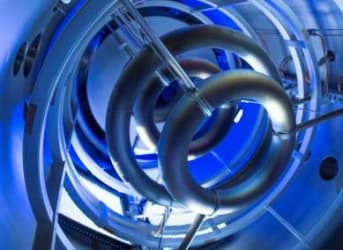Fusion power has been something of a holy grail in the energy field for decades. The idea of harnessing the same energy that powers the sun naturally excites many. At the same time, despite decades of research, fusion energy has yet to come close to being a reality. The only significant practical advance in fusion reactions has been the development of thermonuclear weapons like the hydrogen bomb which, for all intents and purposes, serve the same purpose as conventional nuclear weapons.
Still, even today billions of dollars continues to be poured into fusion research at research labs around the world. And in the last decade, there has been a proliferation of interest in fusion power from commercial sources. The largest company doing work in fusion power is probably Lockheed Martin. Lockheed claims that it will have a prototype reactor in a just a few years’ time and that a commercial product could be coming within a decade.
If that occurs it would be enormously exciting – fusion power offers the potential for vastly more energy production than traditional nuclear energy with virtually no nuclear waste and no greenhouse gases. It is also practically limitless, as its fuel source comes from materials already found abundantly around the world. Related: This Merger Could Signal Big Changes In Nuclear Energy
But, many have rightly expressed skepticism about Lockheed’s claims, given fusion’s long history of near-breakthroughs that don’t come to pass. Thus the onus is very much on the company to show that it has a working product.
Lockheed’s not the only one in the space though. There are several start-ups, backed in many cases by vast investments, which are working toward the goal of commercially viable fusion power. Tri-Alpha, based near Irvine CA, Helion Energy in Redmond, WA, and Lawrenceville Plasma Physics of Middlesex, NJ are all taking serious runs at developing prototype reactors. If one of the firms does manage to come up with a breakthrough design, then the implication would be enormous.
The problem with fusion power is one of engineering, not science. The main hold up is the struggle to contain the plasma and keep it suspended in mid-air away from the sides of the reactor vessel, then heat that matter up to the point that the reaction takes place in earnest. This all requires an enormous amount of energy. Related: Could Natural Gas Dominate Global Transportation Soon?
In fact, in 60 years of trying, no one has been able to consistently demonstrate a process that would let a fusion reactor create more energy than it consumes. All previous fusion reactors have used more energy than they produce. Unfortunately, this is a problem which has stumped many of the greatest minds of the twentieth century, and the problem may prove insurmountable.
There is some hope for the technology though. Tri-Alpha, in particular, has done some innovative things with its reactor designs, which have resulted in much longer-lived fusion reactions than others have previously demonstrated. Tri-Alpha is backed by a massive pile of cash but has been secretive about its work to date. Related: Forget The Noise: Oil Prices Won’t Crash Again
From an investors point of view though, fusion power remains very far from being an investable technology. The work required to make a commercially viable product at this stage is just too great for the vast majority of investors. Add to that the lack of good pure-play investing vehicles, and fusion power for now looks like it is still more science fiction than investment opportunity.
For small investors who are truly excited about the space, Lockheed Martin is a reasonable investment though. The company may or may not have gotten ahead of itself in its recent claims about prototype reactors, but given the size and scale of the firm, there is more than enough diversification to offset any set-backs on the fusion front.
ADVERTISEMENT
By Michael McDonald of Oilprice.com
More Top Reads From Oilprice.com:
- Oil Markets Could Be In For A Shock From China Soon
- Is Elon Musk Just A Billionaire Welfare King?
- Busting The “Canadian Bakken” Myth



















http://protonboron.com/portal/power-grid-frequency-meter/
Why you dont talk about LENR?
Now cold fusion it is a reality.....maybe more of the fusion
The energy required to confine a plasma is not the stumbling block. Keeping energy from leaking out of the plasma too fast is a problem. But even if we had perfect plasma confinement, fusion reactors appear to be far too expensive. Capital cost is the weakness of conventional nuclear power, and fusion only makes the problem worse.
https://www.iter.org/mach
Mankind came into possession of a practical way of generating energy from fusion over 50 years ago with the Ivy-Mike nuclear test that produced fusion energy from pure Deuterium via DD fusion.
Practical fusion will always be 50+ years ago (not 50 years away)
Today, there are smaller pure fusion devices designed to make clean energy (not blast effects) from pure DD fusion of Deuterium separated from sea water. One such design is called mini-Mike, which produces a small predictable controlled energy yield of 250 GJ per shot which produces power at a 1 GWe rate igniting one device a minute.
Note: Deuterium separated from sea water is totally non-radioactive and fusion of this fuel produces only totally non-radioactive nuclear waste (helium).
Will we see practical nuclear fusion any time soon?
http://www.quora.com/Will-we-see-applicable-nuclear-fusion-any-time-soon